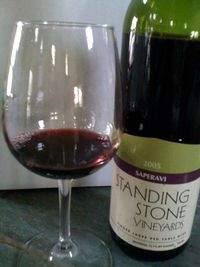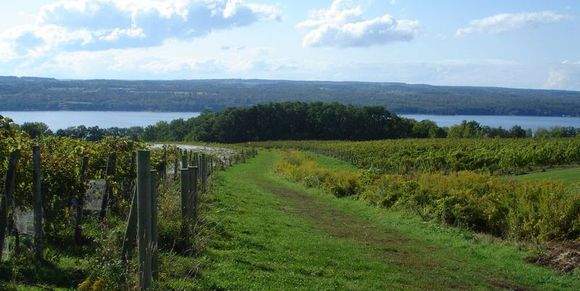By Evan Dawson, Finger Lakes Editor
Marti Macinski is thinking back to the early 1990s, when she first planted Saperavi. We're sitting in her lab, and it's freezing, and she's laughing, which she is almost always doing.
"We had such different expectations for Saperavi," she says. "And look at it now!"
Saperavi is a grape native to the Republic of Georgia, where the word means "ink." It's an appropriate description for the wines that Saperavi makes. In fact, Macinski planted Saperavi in 1994, just a few years after launching Standing Stone Vineyards, because it seemed to have a future as a blending grape.
"Our thinking was that Saperavi would be the secret to pinot," she says. "Even in the best of years, pinot is so light that, if you want to sell it to Americans, you have to beef it up a little."
That little experiment died nearly instantly. "Disaster," she sighs. "Even a drop of Saperavi in a barrel of pinot caused all kinds of problems. I mean a single drop. It was not a fit."
After that, Saperavi did the one thing it can do damn well: grow. Macinski says it's a hearty vinifera, owing to its roots in frosty Georgia. There wasn't much of it at Standing Stone Vineyards — certainly not as much as there is at McGregor Vineyard, where the resulting Black Russian Red has become a wine club favorite — but there was enough for Macinski to begin a new experiment in 2005.
"That was the first time we figured we'd give Saperavi a shot on its own," she says. This time, she doesn't laugh. She just smiles a satisfied smile, like a student who stumbled across a cheat sheet before a big exam. "You know when you taste riesling, you know it works here? That's Saperavi."
But what about the other Standing Stone reds? "I'm proud of our other reds, but it's Saperavi that's distinguished itself as a grape that really belongs here," she says.
It's no small thing for Macinski to make this kind of pronouncement. Listen to her assessment of Finger Lakes winemaking in general: "We're not making the wines I want to make yet. We just don't know enough as a winemaking community. Give us time, because there's something phenomenal in this dirt."
So why is she so confident about Saperavi, having only made a few vintages? "Quality!" she says, laughing as if to say, Why else? But there is something else: That winter hardiness, and the way it yields. The loose clusters make Saperavi resistant to disease.
In 2010, Macinski says her Saperavi cranked out 6.3 tons to the acre (she only has about one acre in the ground). But even with the high yield, she says the grapes showed 24 brix at harvest. "And that's normal!" she explains. "We can't seem to get it below 23 brix. It just produces."
There will be a challenge in educating consumers about what, exactly, Saperavi is. Most have never heard of it. Macinski believes the market will gladly pay $20 to $25 per bottle once they taste it and understand.
But there is another challenge that comes from the government. The TTB does not recognize Saperavi as a winemaking grape in this country, so it can't be labeled as such. Yet. "Oh, we're working on that," Macinski says. (She's also a lawyer, which helps.) "Right now we can't call it Saperavi, so we'll come up with another name for the 200 cases of the 2010. Or maybe the TTB will change its mind next week. We've filled out the paperwork, so we're optimistic."
 We tasted the Standing Stone 2005 Saperavi in the tasting room. Marti's husband Tom joined us, noting that Saperavi "was supposedly Stalin's favorite wine." After the laughter subsided, he acknowledged that perhaps that wasn't the best marketing hook. "It's better described as Uncle Joe's Red," he joked.
We tasted the Standing Stone 2005 Saperavi in the tasting room. Marti's husband Tom joined us, noting that Saperavi "was supposedly Stalin's favorite wine." After the laughter subsided, he acknowledged that perhaps that wasn't the best marketing hook. "It's better described as Uncle Joe's Red," he joked.
The wine is no joke, however. It is dense and full, but soft and mellow in the mouth. There are clear echoes of McGregor's Black Russian Red, with the familiar pomegranate note. This is a unique wine that will stretch the minds of wine lovers. The oak is restrained. Macinski uses neutral, mostly American oak for as much as 18 months. "Oak is a technique, not a flavor," she says, and I almost spin around in the hopes that somehow other winemakers are listening.
I was surprised that, given the McGregor family's local history with this grape, there wasn't more discussion of the Black Russian Red. But Standing Stone is interested in establishing their own profile, while clearly respecting the work of others. In fact, Macinski is actively encouraging her colleagues to give Saperavi a try. "Any grape that's going to be realistically successful in the long run needs at least 20 producers making it," she asserts. "There is strength in numbers. We want to see more of it. If you believe in a variety in a cool climate region like the Finger Lakes, you need to let others know."
With that in mind, Macinski salutes the work of Nancy Irelan across Seneca Lake at Red Tail Ridge. Irelan is growing Teroldego, another red variety with "real potential," Macinski says. "We might not win over the world with our merlot, but we could change minds with Saperavi, or Teroldego, or who knows."
And wouldn't that be funny if the grape that was planted for blending purposes turns out to be the regional star, all on its own? "Saperavi can be a Finger Lakes grape," Macinski says, then adds, "and it might be the Finger Lakes grape."

